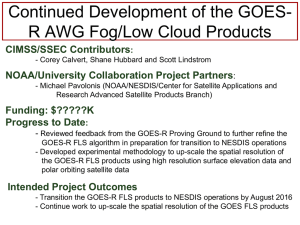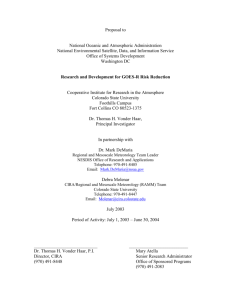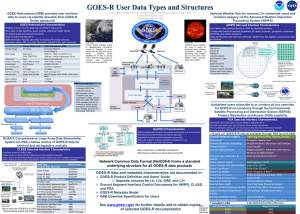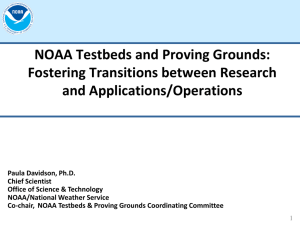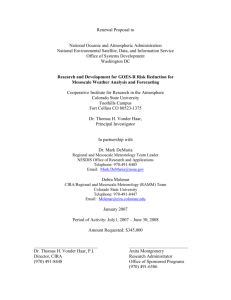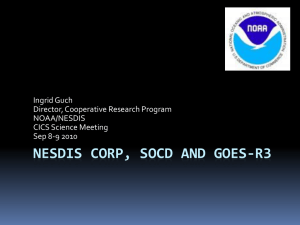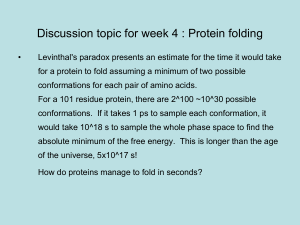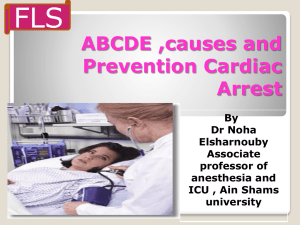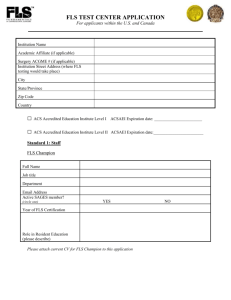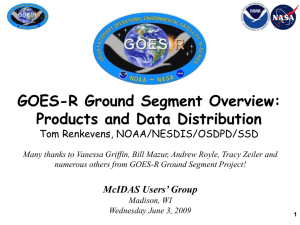102_GOESR3_Jul2013-Jun2014_proj_rep_Calvert
advertisement
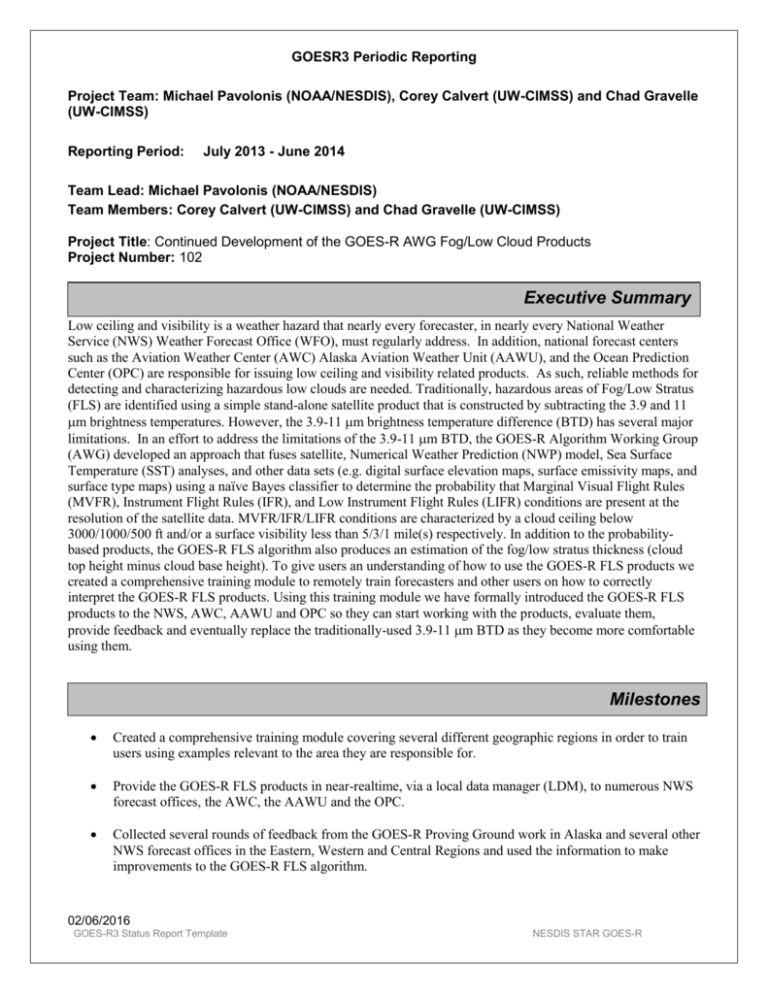
GOESR3 Periodic Reporting Project Team: Michael Pavolonis (NOAA/NESDIS), Corey Calvert (UW-CIMSS) and Chad Gravelle (UW-CIMSS) Reporting Period: July 2013 - June 2014 Team Lead: Michael Pavolonis (NOAA/NESDIS) Team Members: Corey Calvert (UW-CIMSS) and Chad Gravelle (UW-CIMSS) Project Title: Continued Development of the GOES-R AWG Fog/Low Cloud Products Project Number: 102 Executive Summary Low ceiling and visibility is a weather hazard that nearly every forecaster, in nearly every National Weather Service (NWS) Weather Forecast Office (WFO), must regularly address. In addition, national forecast centers such as the Aviation Weather Center (AWC) Alaska Aviation Weather Unit (AAWU), and the Ocean Prediction Center (OPC) are responsible for issuing low ceiling and visibility related products. As such, reliable methods for detecting and characterizing hazardous low clouds are needed. Traditionally, hazardous areas of Fog/Low Stratus (FLS) are identified using a simple stand-alone satellite product that is constructed by subtracting the 3.9 and 11 m brightness temperatures. However, the 3.9-11 m brightness temperature difference (BTD) has several major limitations. In an effort to address the limitations of the 3.9-11 m BTD, the GOES-R Algorithm Working Group (AWG) developed an approach that fuses satellite, Numerical Weather Prediction (NWP) model, Sea Surface Temperature (SST) analyses, and other data sets (e.g. digital surface elevation maps, surface emissivity maps, and surface type maps) using a naïve Bayes classifier to determine the probability that Marginal Visual Flight Rules (MVFR), Instrument Flight Rules (IFR), and Low Instrument Flight Rules (LIFR) conditions are present at the resolution of the satellite data. MVFR/IFR/LIFR conditions are characterized by a cloud ceiling below 3000/1000/500 ft and/or a surface visibility less than 5/3/1 mile(s) respectively. In addition to the probabilitybased products, the GOES-R FLS algorithm also produces an estimation of the fog/low stratus thickness (cloud top height minus cloud base height). To give users an understanding of how to use the GOES-R FLS products we created a comprehensive training module to remotely train forecasters and other users on how to correctly interpret the GOES-R FLS products. Using this training module we have formally introduced the GOES-R FLS products to the NWS, AWC, AAWU and OPC so they can start working with the products, evaluate them, provide feedback and eventually replace the traditionally-used 3.9-11 m BTD as they become more comfortable using them. Milestones Created a comprehensive training module covering several different geographic regions in order to train users using examples relevant to the area they are responsible for. Provide the GOES-R FLS products in near-realtime, via a local data manager (LDM), to numerous NWS forecast offices, the AWC, the AAWU and the OPC. Collected several rounds of feedback from the GOES-R Proving Ground work in Alaska and several other NWS forecast offices in the Eastern, Western and Central Regions and used the information to make improvements to the GOES-R FLS algorithm. 02/06/2016 GOES-R3 Status Report Template NESDIS STAR GOES-R Accomplishments The naïve Bayesian model was retrained using data from the Rapid Refresh (RAP) model. This was necessary since the RAP replaced the Rapid Update Cycle (RUC) in May, 2012. We found a linear relationship between the last nighttime fog/low stratus thickness estimation and the dissipation time for radiation fog events. Initial feedback has shown that the GOES-R FLS thickness product and how it can be used to infer dissipation time is popular among some forecasters. We started to incorporate morphometric landform characterization into the FLS products with goal of utilizing high-resolution topography data to help improve the ability of the GOES-R FLS products to resolve small-scale valley fog events. By modifying the GOES-R IFR probabilities using high-resolution topographic information, the low-resolution GOES IFR probabilities can be altered to capture more smallscale detail previously only available from higher-resolution instruments like MODIS (~1 km) (See figure below). Additional Information 1. Interaction with operational partners – At least 24 WFO’s and 3 National Centres have participated in various live GOES-R AWG FLS training sessions. 2. Outside project publicity – We supported a group from Environment Canada led by Ismail Gultepe working on a SAAWSO field experiment located in Newfoundland, Canada. We provided the GOES-R FLS products as well as other satellite imagery and cloud products in near real-time to assist their research. We also plan on using data obtained from the field experiment to further evaluate the GOES-R FLS products. Leon Majewski of the Australian Bureau of Meteorology (BoM) visited NOAA/CIMSS in Madison, WI during June 2014. During his visit he obtained the updated GOES-R FLS algorithm and other updated cloud products. In the near future the BoM plans on testing and evaluating the FLS products in their region and provide feedback. 4. Plans for operational transition Near real-time processing and distribution of the GOES-R FLS products to operational partners will continue at UW-CIMSS. A follow-on GOES-R3 proposal was funded and will continue to improve the FLS products with eventual transition to operations. 3. Journal articles – A journal article describing and evaluating the GOES-R FLS probability products is nearing completion and will be submitted by the end of the summer. 02/06/2016 GOES-R3 Status Report Template NESDIS STAR GOES-R Key Graphics Figure 1: The upper left is a false color RGB image created using data from MODIS (Aqua) on January 23, 2014 at 09:20 UTC showing a large area of fog (milky green color) across the state of Washington. The upper right image is the corresponding GOES-R IFR probability product applied to the same MODIS scene. The lower left image is the GOES-R IFR probability product applied to GOES-15 on January 23, 2014 at 09:30 UTC. The lower right image is the GOES-R IFR probability product applied to the same GOES-15 scene, however, the probabilities were modified using high spatial resolution (0.5 km) morphometric landform characterization information that allows the relatively low resolution GOES data (~4 km) to better resolve small-scale areas of fog constrained by the local topography. 02/06/2016 GOES-R3 Status Report Template NESDIS STAR GOES-R
